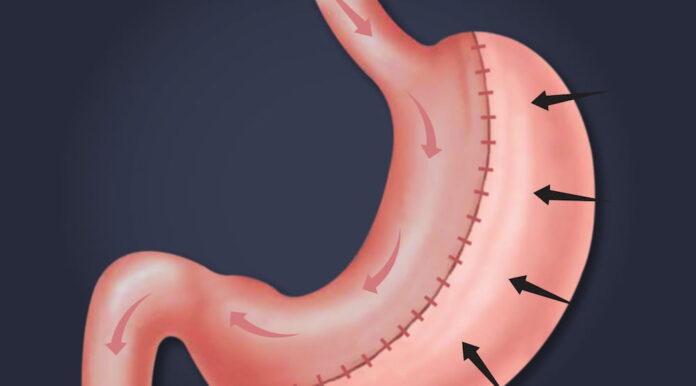For individuals severely impacted by obesity not relieved through diet and fitness changes alone, vertical sleeve gastrectomy offers decisive surgical intervention when health declines sharply amidst prolonged struggles. This restrictive weight loss procedure reduces stomach volume to facilitate portion control and caloric reductions, yielding substantial, enduring results.
Through removing roughly 80% of the stomach, vertical sleeve gastrectomy leaves only a small, banana-shaped “sleeve” pouch capable of holding far less food while connecting directly to the small intestine. This forces lifestyle adherence to smaller, nutritionally dense meals consumed slowly, enabling weight loss through sustained caloric deficits.
It also provides rapid relief from obesity-fueled diseases if efforts towards lasting lifestyle changes are made. Still, a two-day hospital stay is monitored for bleeding, infection, and clot risks before most patients see discharge.
The Basics of Vertical Sleeve Gastrectomy
In vertical sleeve gastrectomy, surgeons remove about 80% of the stomach, leaving a tube-shaped portion or “sleeve.” This reduces stomach size so patients feel full quicker and consume fewer calories, leading to weight loss. It does not reroute intestines for more straightforward digestion.
Why Choose Vertical Sleeve Gastrectomy?
Patients opt for this surgery primarily to lose a significant amount of weight. In addition to weight loss, the procedure can also alleviate or improve related health conditions like type 2 diabetes, high blood pressure, and sleep apnea. It’s often considered when other weight loss methods, like diet and exercise, have failed to produce the desired results.
The Procedure Explained
Performed under general anesthesia, vertical sleeve gastrectomy is usually done laparoscopically, involving small incisions and a camera to guide the surgeon. The process takes about one to two hours. By removing a large part of the stomach, the amount of ghrelin (a hormone that stimulates appetite) produced is reduced, leading to less hunger and decreased calorie intake.
Recovery and Results
Patients typically spend one to two days in the hospital for monitoring post-surgery. Recovery involves gradually transitioning from liquid to solid foods and adhering to a strict diet plan to allow the new stomach structure to heal properly. Most patients experience significant weight loss within the first year after the procedure and improvements in obesity-related conditions.
Risks and Considerations
Like all surgeries, vertical sleeve gastrectomy comes with risks such as infection, bleeding, and potential complications related to anesthesia. Long-term risks include nutritional deficiencies, which require ongoing monitoring and supplementation. It’s crucial for patients considering this surgery to discuss all potential risks and benefits with their healthcare provider.
Conclusion
Vertical sleeve gastrectomy marks intense anatomical intervention when obesity severely impacts health over prolonged periods. Ideal candidates have BMIs exceeding 40 or 35 with life-threatening conditions exacerbated by excess weight yet unrelieved through less invasive means.
While coveted transformations seem realized rapidly through sustained lifestyle changes post-surgery, success depends on embracing this decision’s gravity mentally as much as physically. Stomach restriction opens the door; walking through it daily toward healthier relationships with food and longevity requires a lifelong psychological commitment to substantial behavioral changes.
Did you find this helpful? Check out our other helpful articles on our website.
Read Also
- Ketamine-Assisted Therapies: Impacts on Employee WellbeingWorkplace stress is common today. Many employees feel tired, anxious, or burned out. Regular therapy can help, but some people need more support. Ketamine-assisted therapy is showing good results for mental health. A ketamine-assisted therapist guides each session safely. This therapy can improve mood, focus, and energy. Learning more about it can help teams stay… Read more: Ketamine-Assisted Therapies: Impacts on Employee Wellbeing
- The Future of Men’s Health: Why Telehealth Is Here to StayTelehealth isn’t just a pandemic trend that faded into the background. For Australian men, it has become one of the most practical, time-saving, and stress-free ways to manage everyday health — and it’s shaping the future of how we access care. Platforms like DOCTO, an Australian online doctor and specialist telehealth service, are leading the… Read more: The Future of Men’s Health: Why Telehealth Is Here to Stay
- How to Build a Simple, Clean Skincare Routine ?You don’t need a complicated skincare routine. It doesn’t have to be something that requires twenty different products and confusing steps. Your routine works well with just a few high-quality clean ingredients. The beauty industry keeps pushing more products, but your skin actually needs less. You only need a simple approach to get better results… Read more: How to Build a Simple, Clean Skincare Routine ?
- How Preventive Dental Care Supports Overall HealthHave you ever wondered how a simple dental checkup could impact your entire body? Oral health is more than just a bright smile. Studies show that poor dental habits can contribute to serious health problems. Gum disease and tooth decay are linked to heart disease, diabetes, and infections. Yet, many people overlook preventive dental care.… Read more: How Preventive Dental Care Supports Overall Health
- Seeing Clearly in a High-Tech World: A Deep Dive into Advanced Vision Care ServicesProtecting your eyesight isn’t optional—it’s essential. Modern eye care has evolved far beyond basic exams, offering advanced diagnostics, personalized treatments, and surgical innovations that keep vision sharp for life. A leading example is Intermountain Eye Center, home to specialists like Dr Fishburn Boise, where patients receive comprehensive, high-level vision care designed to preserve long-term eye… Read more: Seeing Clearly in a High-Tech World: A Deep Dive into Advanced Vision Care Services
- Why the Keto Diet Works for Some People—and Fails Dramatically for Others: An Ayurvedic Breakdown for Modern HealthcareThe keto diet has dominated weight-loss culture for years. For some people, it produces rapid fat loss, stable energy, and improved mental clarity. For others—especially those who gain weight easily—it leads to burnout, digestive distress, rebound weight gain, high cholesterol, and a metabolism that feels slower than before. Healthcare often frames this as a discipline… Read more: Why the Keto Diet Works for Some People—and Fails Dramatically for Others: An Ayurvedic Breakdown for Modern Healthcare
- How to Choose the Best Assisted Living Facility for SeniorsAre you looking for the right assisted living facility for a senior loved one? Choosing a place can feel overwhelming. There are many factors to consider, from care services to the environment. Safety, comfort, and social opportunities play important roles in daily life. Each senior has unique needs and preferences that must be met. Understanding… Read more: How to Choose the Best Assisted Living Facility for Seniors
- Burn Smart, Not Hard; Shape Burn: Clean Protein for Weight ManagementYou want to feel light, strong, and confident. You don’t want crash diets or fake promises. You need a plan that works with your body, not against it. That’s where Shape Burn comes in. You can burn fat without losing strength. You can eat better and stay full. You can manage weight in a way… Read more: Burn Smart, Not Hard; Shape Burn: Clean Protein for Weight Management









